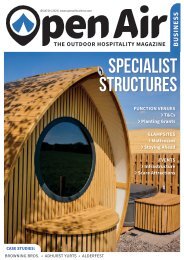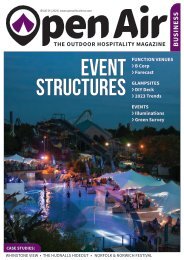Open Air Business April 2017
The UK's outdoor hospitality business magazine for function venues, glampsites, festivals and outdoor events
The UK's outdoor hospitality business magazine for function venues, glampsites, festivals and outdoor events
You also want an ePaper? Increase the reach of your titles
YUMPU automatically turns print PDFs into web optimized ePapers that Google loves.
GLAMPSITES<br />
Power to<br />
the People!<br />
To avoid leaving your clients in the dark, <strong>Open</strong> <strong>Air</strong> <strong>Business</strong><br />
takes a look at off-grid power provision<br />
GETTY IMAGES<br />
BY THEIR VERY nature, the ideal locations<br />
for glamping accommodation are often off<br />
the beaten track and therefore away from<br />
the services that most people take for<br />
granted such as mains drainage, gas and<br />
electricity.<br />
Although the concept of glamping is all<br />
about escaping from the day to day norm,<br />
most glampers expect a certain degree of<br />
luxury, and a feeling of home from home.<br />
For example, many people want to be<br />
contactable and to be able to charge their<br />
mobile phones wherever they are. Where<br />
these services are not easily available,<br />
the challenge is to offer alternatives that<br />
combine the provision of power, and thus<br />
comfort, with the authentic glamping<br />
experience that promotes a feeling of<br />
getting back to nature.<br />
Adrian Williams, managing director of<br />
Solar Technology International, explains:<br />
“As the glamping industry continues<br />
to see growth, its offer of rustic charm<br />
coupled with a sense of understated<br />
luxury can be more fully met with the<br />
provision of off-grid electricity to power<br />
lighting, water pumps and so on. Wiring<br />
up to the grid is not only an expensive<br />
option, but also an impractical one with<br />
the seasonal and sometimes nomadic<br />
nature of glampsites. In addition, the<br />
disruption of the natural landscape<br />
undermines the ‘off-grid’ ethos of<br />
glamping.”<br />
According to Tim Smerdon, owner of<br />
Mobile Solar Chargers and co-owner of<br />
Solar Charging Can, many of those who<br />
choose glamping as an option are city<br />
dwellers and are therefore looking for an<br />
experience that is rural, rustic and above<br />
all quiet. He says: “I think phone charging<br />
is seen as a necessity - people like to<br />
have the option, even though they might<br />
choose not to use it - as is lighting.”<br />
Alicia Whymark, product manager,<br />
Portable Power Technology, agrees<br />
that light and power are an important<br />
commodity to offer your glamping<br />
customers on off-grid sites. “Customers<br />
may want to turn off all their devices<br />
and get right back to nature and some<br />
may want to retain as many creature<br />
comforts as possible, but most will reside<br />
somewhere in the middle,” she says.<br />
“Everyone needs light and energy, it’s just<br />
a question of how much.”<br />
GETTING CONNECTED<br />
So, light and energy are considered<br />
essential, but if you are to avoid potential<br />
noise and disruption to the surrounding<br />
landscape while keeping in mind those<br />
‘green’ credentials, what are the off-grid<br />
options?<br />
Solar power is probably the one<br />
that first springs to mind. The sun can<br />
provide lots of electric power (especially<br />
if your accommodation gets a lot of<br />
solar exposure). However, it is unlikely<br />
to be cost-effective to rely on solar<br />
energy alone. Therefore, solar might be<br />
considered part of the answer rather than<br />
the total solution. Solar panels can be<br />
installed on the roof of a hut or in a sunny<br />
spot nearby. Energy collected by the<br />
panels can then be used to power the hut<br />
directly or to charge a battery. The success<br />
of this option does, however, rely on the<br />
sun exposure of your chosen plot.<br />
If you get good news after you contact<br />
your local weather service to check on<br />
the average wind speed in your area,<br />
generating electricity from residentialsized<br />
wind turbines is another option<br />
for off-grid energy. Knowing the average<br />
and wind speed ranges, you can estimate<br />
how much electricity a given system<br />
will produce. However, you should<br />
keep in mind that wind speeds can vary<br />
significantly from regional averages<br />
depending on local topography.<br />
If you require energy on a small scale,<br />
there are plenty of experts who can offer<br />
28 WWW.OPENAIRBUSINESS.COM


















